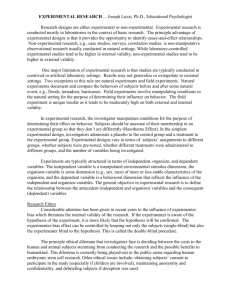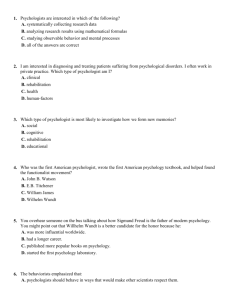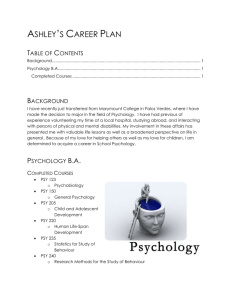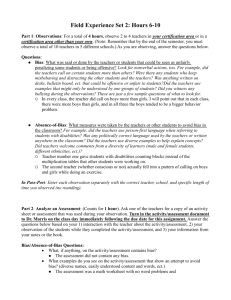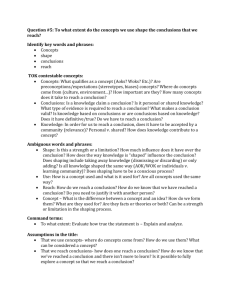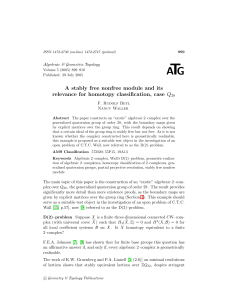1 - Bway.net
advertisement
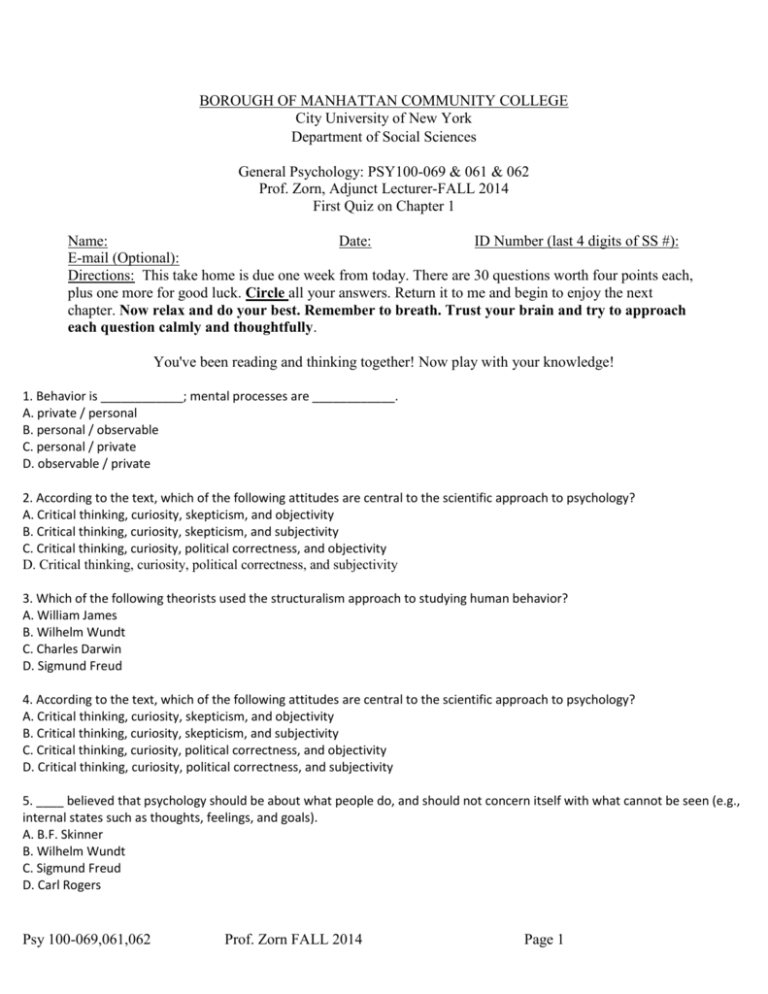
BOROUGH OF MANHATTAN COMMUNITY COLLEGE City University of New York Department of Social Sciences General Psychology: PSY100-069 & 061 & 062 Prof. Zorn, Adjunct Lecturer-FALL 2014 First Quiz on Chapter 1 Name: Date: ID Number (last 4 digits of SS #): E-mail (Optional): Directions: This take home is due one week from today. There are 30 questions worth four points each, plus one more for good luck. Circle all your answers. Return it to me and begin to enjoy the next chapter. Now relax and do your best. Remember to breath. Trust your brain and try to approach each question calmly and thoughtfully. You've been reading and thinking together! Now play with your knowledge! 1. Behavior is ____________; mental processes are ____________. A. private / personal B. personal / observable C. personal / private D. observable / private 2. According to the text, which of the following attitudes are central to the scientific approach to psychology? A. Critical thinking, curiosity, skepticism, and objectivity B. Critical thinking, curiosity, skepticism, and subjectivity C. Critical thinking, curiosity, political correctness, and objectivity D. Critical thinking, curiosity, political correctness, and subjectivity 3. Which of the following theorists used the structuralism approach to studying human behavior? A. William James B. Wilhelm Wundt C. Charles Darwin D. Sigmund Freud 4. According to the text, which of the following attitudes are central to the scientific approach to psychology? A. Critical thinking, curiosity, skepticism, and objectivity B. Critical thinking, curiosity, skepticism, and subjectivity C. Critical thinking, curiosity, political correctness, and objectivity D. Critical thinking, curiosity, political correctness, and subjectivity 5. ____ believed that psychology should be about what people do, and should not concern itself with what cannot be seen (e.g., internal states such as thoughts, feelings, and goals). A. B.F. Skinner B. Wilhelm Wundt C. Sigmund Freud D. Carl Rogers Psy 100-069,061,062 Prof. Zorn FALL 2014 Page 1 6. Which of the following schools of thought focuses on the unconscious aspects of human thought and behavior? A. Behaviorism B. Humanistic psychology C. Cognitive psychology D. Psychoanalysis 7. According to the ______, we are in control of our lives and have the capacity for positive growth. A. humanistic approach B. psychodynamic approach C. cognitive approach D. behaviorism approach 8. The ____ approach relies on concepts such as adaptation, reproduction, and natural selection when explaining human behavior. A. humanistic B. psychodynamic C. evolutionary D. behavioral 9. Which of the following approaches to psychology focuses on how we direct our attention, perceive, remember, think, and solve problems? A. Sociocultural B. Behavioral C. Cognitive D. Psychodynamic 10. The ____ approach focuses on comparisons of behavior across countries as well as on the behavior of individuals from different ethnic and cultural groups within a country. A. psychodynamic B. sociocultural C. cognitive D. behavioral 11. Which of the following is NOT an essential feature of the scientific method? A. Developing and testing hypotheses B. Drawing and evaluating conclusions C. Observing some phenomenon D. Publishing politically correct results 12. A(n) ____ is a broad idea or closely related set of ideas that attempts to explain observations and to make predictions about future observations. A. theory B. hypothesis C. operational definition D. experimenter bias. Psy 100-069,061,062 Prof. Zorn FALL 2014 Page 1 13. ____ is the first step in the scientific method. A. Evaluating conclusions B. Formulating hypotheses C. Observing some phenomenon D. Testing through empirical research 14. _____ provide an objective description of how variables are going to be measured and observed in a particular study. A. Independent variables B. Operational definitions C. External validity checks D. Experimenter biases 15. Case studies ______. A. involve gathering in-depth information on a single subject or participant B. are useful for studying large populations C. involve random assignment of participants D. rely on the experimental method 16. Longitudinal research involves ______. A. obtaining measures of the variables of interest in multiple waves over time B. randomly assigning participants to the control and experimental groups C. the random selection of participants within a particular population D. uncovering unconscious motives and conflicts 17. Which of the following research methods allow researchers to determine causality? A. Survey studies B. Correlational studies C. Experimental studies D. All of these 18. ______ involves using a chance procedure to guarantee that each participant has an equal probability of being assigned to either the control or experimental group. A. Selection bias B. Experimenter bias C. Random assignment D. Random selection 19. In an experiment the ______ is manipulated by the researcher and its effects on the _____ are measured. A. dependent variable/ independent variable B. independent variable/ dependent variable C. confounding variable/ independent variable D. dependent variable/ confounding variable 20. B. F. Skinner discovered that a pigeon will peck at a button more often if the pecking is rewarded with a food pellet than if it is not rewarded at all. In Skinner’s study, the amount of pecking is the _____. Psy 100-069,061,062 Prof. Zorn FALL 2014 Page 1 A. dependent variable B. experimental variable C. independent variable D. third variable 21. ____refers to the degree to which an experimental design actually reflects the real-world issues it is supposed to address. A. Internal validity B. External validity C. Face validity D. Reliability 22. ______ refers to the degree to which changes in the dependent variable are due to the manipulation of the independent variable. A. Internal validity B. External validity C. Face validity D. Reliability 23. Aspects of a study that communicate to the participants how the experimenter wants them to behave are known as _____. A. research cues B. participant effects C. confederates D. demand characteristics 24. The placebo effect is an example of a(n) _____. A. experimenter bias B. participant bias C. random assignment bias D. random selection bias 25. In a ____, neither the participants nor the experimenter know which group has received the treatment. A. double-blind experiment B. single blind experiment C. longitudinal design D. case study 26. A ____ is the entire group about which the investigator wants to draw conclusions, whereas a ____ is the subset of the population selected to participate in the study. A. sample / population B. population / sample C. sample / confederate D. population / confederate 27. A population is ____. A. the entire group of people researchers want to draw conclusions about Psy 100-069,061,062 Prof. Zorn FALL 2014 Page 1 B. a smaller subset of a group of people researchers want to draw conclusions about C. the small number of individuals who agree to participate in the study D. randomly defined 28. ______ is about making sure experimental and control groups are equivalent, and ________ is about selecting participants from a population so that the sample is representative of that population. A. Reliability / internal validity B. External validity / internal validity C. A random sample / random assignment D. Random assignment / a random sample 29. The ____ establishes ethical guidelines for psychologists. The ____ evaluates the ethical nature of research conducted at colleges and universities. A. Institutional Review Board (IRB) / American Psychological Association (APA) B. American Psychological Association (APA) / Institutional Review Board (IRB) C. county government / state government D. state government / county government . 30. According to the principle of ____, researchers must disclose the purpose of the study to their participants and inform them of any potential risks and benefits that are associated with taking part in the study. A. deception B. informed consent C. confidentiality D. freedom from harm And one more for good luck… 31. Deception in research is ethically allowed ___________. A. under no circumstances B. only when a double-blind study is used and all of the participants are over 18 C. in medical research only D. if the anticipated benefits outweigh the anticipated costs and participants are debriefed Thanks for studying so hard and thinking! Here are some quotes to read… Psy 100-069,061,062 Prof. Zorn FALL 2014 Page 1 “Genius may have its limitations, but stupidity is not thus handicapped.” -- Elbert Hubbard “Any excuse will serve a tyrant.” -- Aesop “The greatest discovery of my generation is that a human being can alter his life by altering his attitudes of mind.” -- William James "We know truth, not only by reason, but also by heart." -- Blaise Pascal “The best use of life is to use it for something that outlasts life.” -- William James The human race has one really effective weapon, and that is laughter. -- Mark Twain “Three things in human life are important. The first is to be kind. The second is to be kind. And the third is to be kind." --Henry James There are two types of people in this world, good and bad. The good sleep better, but the bad seem to enjoy the waking hours much more. -- Woody Allen The man who follows the crowd will usually get no further than the crowd. The man who walks alone is likely to find himself in places no one has ever been. -- Alan Ashley-Pitt Psy 100-069,061,062 Prof. Zorn FALL 2014 Page 1
